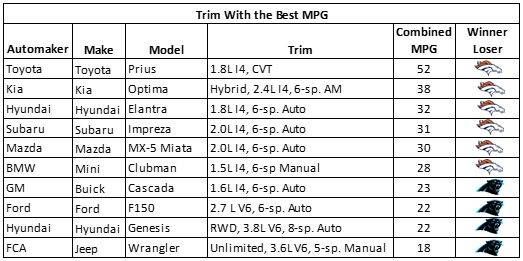Automakers spent an estimated 90 million dollars on Super Bowl ads, one of the most watched shows in the history of television. Now that gas prices are at historical lows, are the car companies going back to promoting their gas guzzlers? The good news is that the majority of vehicles shown in the Super Bowl ads are CAFE compliant. The bad news is that a few penalty flags were flying as automakers promoted cars that fail to deliver fuel economy savings to consumers.
Looking at the 10 manufacturers advertising during the Super Bowl, 9 either specifically promoted or alluded to current model vehicles. The Super Bowl fuel economy winners were the Ford F-150, Hyundai Elantra, Kia Optima, Mazda MX-5, Mini Clubman, Subaru Impreza, and Toyota Prius with all, or some of their mentioned trim lines CAFE compliant. Receiving Super Bowl CAFE penalty flags were the Buick Cascada, Hyundai Genesis and Jeep Wrangler, with none of their advertised vehicles being CAFE compliant.
We also analyzed the overall best and worst among the 10 specific models promoted on the Super Bowl and assigned them to the winning and losing teams.
For the past 12 months, the overall fleet average mpg was 25.3 mpg. Joining the Broncos as this year’s Super Bowl car ad champions for fuel efficiency were the Toyota Prius, Kia Optima and Mazda MX-5. On the losing side, Jeep Wrangler, Ford F-150 and Buick Cascada were the most fuel inefficient models in the Super Bowl ads. Although below the fleet average, the Ford F-150 does have models which are CAFE compliant due to its larger footprint.
In CFA’s national surveys, consumers regularly express concerns about future gasoline prices. Consumers understand that the best offense is a good defense, so the only way to avoid being blindsided by a gasoline price blitz is to buy more fuel efficient vehicles.
Gasoline is still a necessity of daily life and a very large household budget item. Even at $2.00 a gallon, the average household spends about $1,500 a year on gasoline, which is about as much as electricity, telephone service and household equipment and furnishings. Even at today’s lower gas prices, spending more for fuel efficient vehicles is a good investment – the savings on fuel exceeds the cost of the technology over the life of the vehicle.
Consumers buying (and manufacturers selling) for fuel efficiency is a critically important factor for both consumers’ pocketbooks and manufacturer’s financial viability CFA. Buying a fuel inefficient vehicle during times of low gas prices can subject household finances to a huge burden in one to two years if gas prices rise. In addition, who can forget the need to bail out the car companies when they were stuck with millions of unsold gas guzzlers when the price of gas went up?


